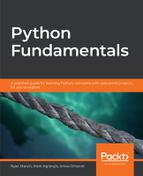Python Fundamentals
A practical guide for learning Python, complete with real-world projects for you to explore
Ryan Marvin, Mark Ng'ang'a, and Amos Omondi
Python Fundamentals
Copyright © 2018 Packt Publishing
All rights reserved. No part of this book may be reproduced, stored in a retrieval system, or transmitted in any form or by any means, without the prior written permission of the publisher, except in the case of brief quotations embedded in critical articles or reviews.
Every effort has been made in the preparation of this book to ensure the accuracy of the information presented. However, the information contained in this book is sold without warranty, either express or implied. Neither the authors, nor Packt Publishing, and its dealers and distributors will be held liable for any damages caused or alleged to be caused directly or indirectly by this book.
Packt Publishing has endeavored to provide trademark information about all of the companies and products mentioned in this book by the appropriate use of capitals. However, Packt Publishing cannot guarantee the accuracy of this information.
Authors: Ryan Marvin, Mark Ng'ang'a, and Amos Omondi
Managing Editor: Taabish Khan
Acquisitions Editor: Koushik Sen
Production Editor: Nitesh Thakur
Editorial Board: David Barnes, Ewan Buckingham, Simon Cox, Manasa Kumar, Alex Mazonowicz, Douglas Paterson, Dominic Pereira, Shiny Poojary, Saman Siddiqui, Erol Staveley, Ankita Thakur, and Mohita Vyas
First Published: October 2018
Production Reference: 1311018
ISBN: 978-1-78980-732-5
